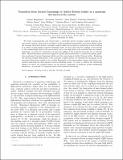Files in this item
Transition from Jaynes-Cummings to Autler-Townes ladder in a quantum dot-microcavity system
Item metadata
| dc.contributor.author | Hopfmann, Caspar | |
| dc.contributor.author | Carmele, Alexander | |
| dc.contributor.author | Musiał, Anna | |
| dc.contributor.author | Schneider, Christian | |
| dc.contributor.author | Kamp, Martin | |
| dc.contributor.author | Höfling, Sven | |
| dc.contributor.author | Knorr, Andreas | |
| dc.contributor.author | Reitzenstein, Stephan | |
| dc.date.accessioned | 2017-01-05T10:30:13Z | |
| dc.date.available | 2017-01-05T10:30:13Z | |
| dc.date.issued | 2017-01-06 | |
| dc.identifier | 248678736 | |
| dc.identifier | 5815a656-cf52-414d-9752-e01be9d06bed | |
| dc.identifier | 85010720870 | |
| dc.identifier | 000391309700001 | |
| dc.identifier.citation | Hopfmann , C , Carmele , A , Musiał , A , Schneider , C , Kamp , M , Höfling , S , Knorr , A & Reitzenstein , S 2017 , ' Transition from Jaynes-Cummings to Autler-Townes ladder in a quantum dot-microcavity system ' , Physical Review. B, Condensed matter and materials physics , vol. 95 , no. 3 , 035302 . https://doi.org/10.1103/PhysRevB.95.035302 | en |
| dc.identifier.issn | 2469-9950 | |
| dc.identifier.uri | https://hdl.handle.net/10023/10044 | |
| dc.description | The research leading to these results has received funding from the German Research Foundation (DFG) via Projects No. Ka2318/4-1 and No. Re2974/3-1, the SFB 787 "Semiconductor Nanophotonics: Materials, Models, Devices", and from the European Research Council under the European Union's Seventh Framework ERC Grant Agreement No. 615613. A. C. gratefully acknowledges support from SFB 910: "Control of self-organizing nonlinear systems". | en |
| dc.description.abstract | We study experimentally and theoretically a coherently-driven strongly-coupled quantum dot-microcavity system. Our focus is on physics of the unexplored intermediate excitation regime where the resonant laser field dresses a strongly-coupled single exciton-photon (polariton) system resulting in a ladder of laser-dressed Jaynes-Cummings states. In that case both the coupling of the emitter to the confined light field of the microcavity and to the light field of the external laser are equally important, as proved by observation of injection pulling of the polariton branches by an external laser. This intermediate interaction regime is of particular interest since it connects the purely quantum mechanical Jaynes-Cummings ladder and the semi-classical Autler-Townes ladder. Exploring the driving strength-dependence of the mutually coupled system we establish the maximum in the resonance fluorescence signal to be a robust fingerprint of the intermediate regime and observe signatures indicating the laser-dressed Jaynes-Cummings ladder. In order to address the underlying physics we excite the coupled system via the matter component of fermionic nature undergoing saturation - in contrast to commonly used cavity-mediated excitation. | |
| dc.format.extent | 11 | |
| dc.format.extent | 3437578 | |
| dc.language.iso | eng | |
| dc.relation.ispartof | Physical Review. B, Condensed matter and materials physics | en |
| dc.subject | QC Physics | en |
| dc.subject | T Technology | en |
| dc.subject | NDAS | en |
| dc.subject.lcc | QC | en |
| dc.subject.lcc | T | en |
| dc.title | Transition from Jaynes-Cummings to Autler-Townes ladder in a quantum dot-microcavity system | en |
| dc.type | Journal article | en |
| dc.contributor.institution | University of St Andrews. School of Physics and Astronomy | en |
| dc.contributor.institution | University of St Andrews. Condensed Matter Physics | en |
| dc.identifier.doi | 10.1103/PhysRevB.95.035302 | |
| dc.description.status | Peer reviewed | en |
This item appears in the following Collection(s)
Items in the St Andrews Research Repository are protected by copyright, with all rights reserved, unless otherwise indicated.

